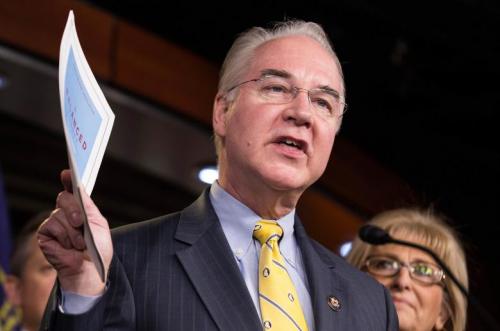Both nominees will drive Trump’s commitment to repeal and replace Obamacare. Here’s what healthcare leaders need to know about these nominees.

Trump announced that he will nominate Tom Price to lead the Department of Health and Human Services.
Price, 62, an orthopedic surgeon from Georgia and one of the original Tea Party caucus members, has served since 2015 as chairman of the House of Representatives’ Budget Committee. There, he was a leader of efforts dismantle the health law, also known as the Affordable Care Act, and has supported GOP plans to overhaul other major health programs. (Bloomberg)
From NPR, here are five key planks in his own health care proposal – and how it differs from the one put forth by Ryan.
- Price’s plan offers fixed tax credits so people can buy their own insurance on the private market. The credit starts at $1,200 a year and rises with age – but unlike Ryan’s plan, it’s not adjusted for income. Everyone receives the same credit whether they are rich or poor. People on Medicaid, Medicare, the military health plan known as Tricare, or the Veterans Affairs’ health plan could opt instead for the tax credit to buy private insurance.
- Price advocates for expansion of health savings accounts, which allow people to save money before taxes to pay for health care. This includes allowing people who are covered by government health programs including Medicare and the VA to contribute to health savings accounts to pay for premiums and copayments. These proposals are included in Ryan’s plan.
- People with existing medical conditions couldn’t be denied coverage under Price’s plan as long as they had continuous insurance for 18 months prior to selecting a new policy. If they didn’t, then they could be denied coverage for that condition for up to 18 months after buying a new plan.
- The Price proposal limits the amount of money companies can deduct from their taxes for employee health insurance expenses. Companies can deduct up to $20,000 for a family health insurance plan and $8,000 for an individual. The goal is to discourage companies from offering overly generous insurance benefits to their workers. Ryan’s plan proposes a cap on the employer tax deduction but doesn’t specify the level of the cap.
- States would get federal money to create so-called high-risk pools under Price’s plan. These are government-run health plans for people with existing medical conditions who can’t get affordable health insurance on the private market. Critics say high-risk pools have been tried in as many as 34 states and largely failed because they were routinely underfunded.
Price has said he’s not wedded to his own ideas and is open to compromise, so the final proposal to replace Obamacare is likely to be a hybrid of his ideas and those hammered out with other Republican House members and presented as Ryan’s plan.

Seema Verma, Trump’s pick for CMS Administrator, is currently is the President, CEO and founder of SVC, Inc, a national health policy consulting company.
For more than 20 years, she has worked extensively on a variety of policy and strategic projects involving Medicaid, insurance, and public health, working with Governors’ offices, state medicaid agencies, state health departments, state departments of insurance, as well as the federal government, private companies and foundations. (Times of India)
Verma was instrumental in Indiana’s implementation of the Obamacare Medicaid expansion. She is best known for her work on Medicaid issues and her close ties to Vice President-elect Mike Pence.
She designed his Obamacare Medicaid expansion model, Healthy Indiana Plan 2.0, and has advised several Republican states on how to add conservative elements such as health savings accounts and employment requirements to their programs.
The consulting executive has also worked on Kentucky’s Medicaid expansion proposal, where controversial Governor Matt Bevin has threatened to pull the plug unless the Obama administration approves his pending request, which includes a work requirement as a condition of receiving benefits and lockout periods for failure to pay. (CitizenSlant)
Don’t miss a story from over 25 healthcare news sources. Download the free Medibeat iOS app.
